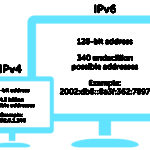Every time you see some network settings, there is IPv4 or IPv6. As you can guess, the previous versions are long in the past (TCP/IP v1,v2, and v3). But why is it IPv4 vs IPv6 instead of the 5th version vs the 6th? How is that the IPv4 from the 80s is still around? Let’s find out!
What is IP?
IP stands for Internet Protocol. The IP is the way devices connect to the internet. It has a set of rules that define how the data travels from host to destination. Each device that is connected with the internet is assigned an IP address that acts as an identifier for a specific machine on a particular network.

What is IPv4?
IPv4 was the first version of IP that was deployed for production in ARPANET. It uses a 32-bit address scheme allowing to store 2^32 addresses which is more than 4 billion addresses. Example -198.167.20.50 It has 4 numbers that can be from 0 to 254, and are divided by dots.
What is IPv6?
As the number of IoT devices keeps on increasing day by day the demand for IPv4 could exceed the supply that is why IPv6 comes to the picture. It uses a 128-bit address scheme and allows 340 undecillion unique address space. It has 8 groups each group consists of 4 hexadecimal digits separated by colons. Example- 2001:0db8:0000:0042:0000:8a2e:0370:7334.
Why not IPv5?
With IPv5 using the same 32-bit addressing, it would have suffered from the same limitation. It was initially planned as a streaming protocol but died as a draft, to avoid confusion IPv6 was introduced.
IPv4 vs IPv6
|
IPv4 |
IPv6 |
| It has a 32-bit IP address. | It has a 128-bit IP address. |
| 576 bytes packet size, fragmentation optional. | 1280 bytes packet size without fragmentation. |
| Includes a checksum. | It does not include a checksum. |
| IPv4 is a numeric address, and its binary bits are separated by a dot (.) | IPv6 is an alphanumeric address whose binary bits are separated by a colon (:). It also contains hexadecimal. |
| Supports broadcast, multicast addressing. | Supports unicast, multicast addressing. |
| IPv4 offers five different classes of IP Addresses. Class A to E. | IPv4 offers five different classes of IP Addresses. Class A to E. |
| It supports VLSM (Virtual Length Subnet Mask). | It does not offer support for VLSM. |
| Fragmentation is done by sending and forwarding routes. | Fragmentation can only be done by the sender. |
| It Supports Manual and DHCP address configuration | It supports Auto and renumbering address configuration |
| It consists of a header of 20-60 bytes. | It has a header of 40 bytes. |
| Encryption and authentication facility is not provided. | Encryption and authentication facility is provided. |
| The security of IPv4 is dependent on the application. | IPSEC is an inbuilt security feature in IPv6 protocol. |
| It uses NAT (Network Address Translation) to mask thousands of non-routable addresses. | It does not use NAT instead it uses direct addressing due to the availability of vast address space. |
| Uses ARP (Address Resolution Protocol) to map to MAC address. | Uses NDP (Neighbour Discovery Protocol) to map to MAC address. |
Conclusion
We can conclude that at one point in future IPv4 will get extinct hence the use of IPv6 will come handy. The adoption of IPv6 has been delayed due to network address translation (NAT), which takes private IP addresses and turns them into public IP addresses. But those IPv4 addresses are limited and nearing exhaustion anytime soon.
I hope that this post would be helpful to you. If you face any queries, feel free to comment below and I’ll surely help you.
If you want to learn the layers of OSI Models in Computer network, check out our recent post The 7 layers of OSI Model explained
Get latest tech news and updates, programming tutorials and cyber security tips and tricks. Check out MeuSec for more.
Sometimes we include links to online retail stores and/or online campaigns. If you click on one and make a purchase we may receive a small commission.

Comments:
1 reply on “IPv4 vs IPv6: Where did IPv5 go?”
Thankyou for this rattling post, I am glad I observed this internet site on yahoo.